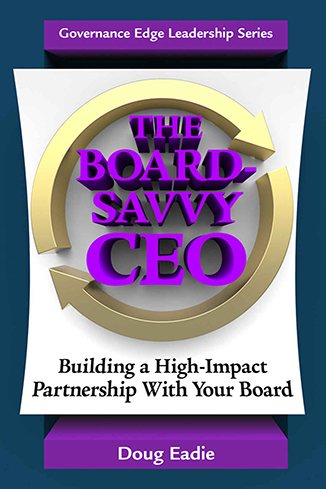 I recently sat in on a fascinating work session involving a nonprofit board’s performance oversight and monitoring committee, the CEO, CFO and three other senior executives. They spent around two hours thinking through the kinds of information that the committee (and ultimately the full board) needed to see – in what format and how frequently – to carry out the committee’s performance oversight and monitoring role fully. What a contrast this was to the traditional approach of a board’s just receiving whatever information has always been sent and trying to figure out how to use it. I learned early on in my work with boards that information is not in and of itself power and that some of the most fully informed boards are the weakest in terms of governing impact. CEOs with a control fetish are often virtuosos at keeping their boards so busy reading that they do not have time to meddle in important matters that these controlling CEOs believe are best left to themselves.
I recently sat in on a fascinating work session involving a nonprofit board’s performance oversight and monitoring committee, the CEO, CFO and three other senior executives. They spent around two hours thinking through the kinds of information that the committee (and ultimately the full board) needed to see – in what format and how frequently – to carry out the committee’s performance oversight and monitoring role fully. What a contrast this was to the traditional approach of a board’s just receiving whatever information has always been sent and trying to figure out how to use it. I learned early on in my work with boards that information is not in and of itself power and that some of the most fully informed boards are the weakest in terms of governing impact. CEOs with a control fetish are often virtuosos at keeping their boards so busy reading that they do not have time to meddle in important matters that these controlling CEOs believe are best left to themselves.
How liberating it was – and ultimately how much higher impact – for the board committee whose work session I sat in on to decide with the CEO and senior executives that they needed to see a quarterly report presenting actual vs. planned expenditures and revenues (for the month and year-to-date) for the nonprofit as a whole, and by each of its major operating units and programs. They also decided they wanted expenditures to be presented by major cost category (for the overall agency picture and for the individual operating units), and revenues to be presented by major source so they could become more knowledgeable about the dynamics of revenue generation. And by the way, they also wanted the staff to experiment with using bar charts and line graphs to make the committee’s monitoring job easier and more enjoyable.
A far weaker approach that I’ve observed over the years would have been for the committee to start with a given set of reports, and then try to figure out how to use them in monitoring, or how they might be fixed up a bit to make them more useful monitoring tools. Taking current information as a given is truly a classic case of the proverbial tail wagging the dog all over the place. Real influence lies in rising above the detail, asking at the highest level what the board needs to know, then translating this into more detailed information bites that will indicate how well your nonprofit is performing, and then moving to a more detailed design level, deciding in what form and how often the information should be transmitted to the performance oversight and monitoring committee.
By the way, this CEO’s being willing to have such interaction with her board’s monitoring committee sent a clear signal that she felt secure, trusted the board, and saw no need to keep staff arms-length from board members. She, therefore, strengthened her credibility and her emotional line of credit with the board while also helping the committee strengthen its monitoring role.





